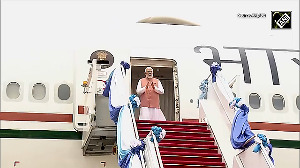Finance Minister Nirmala Sitharaman on Saturday unveiled 'transformative' tax reforms that ranged from a simpler income tax law to higher TCS threshold for remittances and income tax benefits for middle class.

Sitharaman in 2025-26 Budget promised to bring a simpler, less volumnous new law to replace six decades old law governing income tax, saying it will have the spirit of 'Nyay' (justice) and will work on the principle of 'trust first, scrutinise later'.
She also extended the time limit to four years for individuals filing updated tax returns.
Updated returns are filed by taxpayers who had omitted to report their correct income.
Currently, such returns can be filed within two years of the relevant assessment year.
Nearly 90 lakh taxpayers have voluntarily updated their incomes by paying additional tax.
Over the past 10 years, our government has implemented several reforms for convenience of tax payers, such as faceless assessment, tax payers charter, faster returns, almost 99 per cent returns being on self-assessment, and Vivad se Vishwas scheme.
Sitharaman in her Budget speech said the objectives of her taxation proposal are reforms in Personal Income Tax with special focus on middle class, rationalisation of TDS/TCS for easing difficulties and voluntary compliance.
The Budget increased the threshold for tax deduction at source for better clarity and uniformity.
In the FY26 Budget, the limit for TDS deduction on interest for senior citizens has been doubled to Rs 1 lakh from the present Rs 50,000.
Similarly, the annual limit of Rs 2.40 lakh for TDS on rent is being increased to Rs 6 lakh. This will reduce the number of transactions liable to TDS, thus benefitting small tax payers receiving small payments, Sitharaman said.
The threshold to collect tax at source (TCS) on remittances under RBI's Liberalized Remittance Scheme (LRS) too has been increased from Rs 7 lakh to Rs 10 lakh.
The TCS on remittances for education purposes, where such remittance is out of a loan taken from a specified financial institution, has been exempted.
The Budget 2025-26 gave a relief to middle class with regard to tax incidence and rejigged slabs.
Sitharaman announced that annual income of up to Rs 12 lakh will be exempt from I-T under the new income tax regime. For salaried taxpayers, this income threshold will be Rs 12.75 lakh after taking into account standard deduction.
As per the rejig, for people earning more than Rs 12 lakh per annum, there will be nil tax for income up to Rs 4 lakh, 5 per cent for income between Rs 4 and 8 lakh, 10 per cent for Rs 8-12 lakh, and 15 per cent for Rs 12-16 lakh.
A 20 per cent income tax will be levied on income between Rs 16 and 20 lakh, 25 per cent on Rs 20-24 lakh and 30 per cent above Rs 24 lakh per annum.
A tax payer in the new regime with an income of Rs 12 lakh will get a benefit of Rs 80,000 in tax. A person having income of Rs 18 lakh will get a benefit of Rs 70,000 in tax.
A person with an income of Rs 25 lakh gets a benefit of Rs 1.10 lakh.
"The new structure will substantially reduce the taxes of the middle class and leave more money in their hands, boosting household consumption, savings and investment," Sitharaman said in her Budget speech.
The new income tax regime offers lower tax rates and only standard deduction of Rs 75,000 and Rs 15,000 deduction for family pension.
However, the Budget has not made any changes in tax slabs under the old income tax regime, which includes host of tax exemptions and deductions.











 © 2025
© 2025